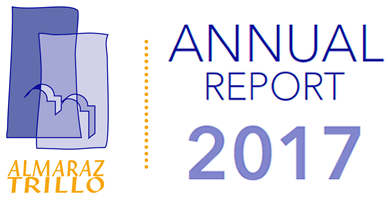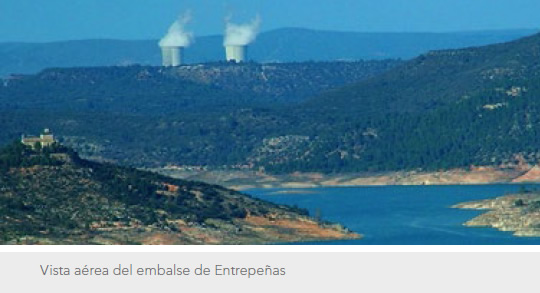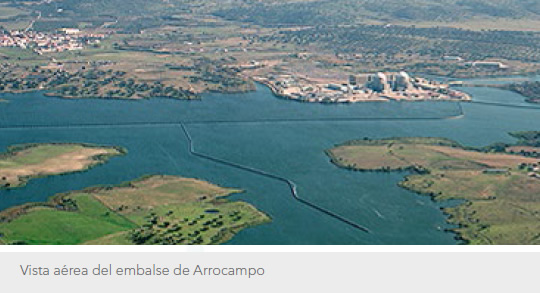
 ENVIRONMENT
ENVIRONMENT
ENVIRONMENTAL QUALITY MANAGEMENT
A.I.E CC.NN.’s commitment to respect the Environment is expressed in the organisation’s Environmental Policy.
The Environmental Policy drives application of the Environmental Management System and its continuous improvement, reflecting the Board’s commitment and constituting the starting principles on which the annual objectives programme is based, and in more general terms, activities of the company in relation to the Environment.
 ENVIRONMENT
ENVIRONMENT
ENVIRONMENTAL POLICY
The mission of A.I.E. CENTRALES NUCLEARES ALMARAZ-TRILLO is to produce electricity in a manner which is safe, reliable, economic, respectful of the environment and which guarantees production over the long term, by optimum operation of the Almaraz and Trillo nuclear power plants, and an Environmental Policy has been defined appropriate to its nature, magnitude and environmental impact, which serves as a reference for the establishment and review of objectives and environmental aims, and based on this, it commits to:
- Comply with the environmental legislation in force and other voluntarily accepted requirements, whilst maintaining an attitude of ongoing adherence.
- Fully integrated the environmental dimension and respect for the natural environment, in the strategy of the organisation.
- Take note of and evaluate the opportunities and environmental risks in relation to activities performed, to guarantee achievement of the expected results.
- Operate installations with respect for the environment, identifying, preventing, controlling and minimising as far as possible, the environmental impact of its activities.
- Continually making improvements to all processes which could have environmental repercussions.
- Controlling and reducing, as far as reasonably possible, leakages, and conventional and nuclear waste.
- Motivating and training staff to respect the environment, stimulating development an environmental culture and communicating the Environmental Policy within and outside the Organisation.
- Report, in a transparent manner, environmental actions and results, maintaining the appropriate channels to encourage communication with interest groups.
- Introduce and maintain updated a standard Environmental Management System.
 ENVIRONMENT
ENVIRONMENT
ACTION PLANS
Almaraz-Trillo Nuclear Plants have continued to perform significant activities in relation to environmental issues during 2017, which are incorporated in the Environmental Management Programme, the most significant of which are detailed below:
- Reduction of the production of radioactive waste: optimisation of the design to minimise leakage of chemical products with impact on the generation of radioactive waste, and material declassification methodologies.
- Enhancing Legionella control in cooling towers, by changing the tower filling.
- Modifications to chillers with a view to the complete elimination of the use of fluorinated gases impacting the ozone layer.
- Control of environmental impacts in the aquatic environment: implementation of an oxygen and temperature telemetering system in the Arrocampo reservoir and reduction of the need for cleansings in the Trillo NPP catchment, through the installation of a floating barrier.
- Reduction of the risk of spills of chemical products.
- Actions to reduce the consumption of paper and toner throughout the organisation.
With regard to high level waste constituted by spent fuel extracted from the reactor, Almaraz began the construction of an Independent Spent Fuel Storage Installation (ISFSI), after having obtained a favourable Environmental Impact Declaration Resolution issued by MAGRAMA and the corresponding administrative authorisation from MINETAD.
The project was implemented throughout 2017 and is almost completed.
 ENVIRONMENT
ENVIRONMENT
ENVIRONMENTAL AUDITS
The Environmental Management System of Centrales Nucleares Almaraz – Trillo A.I.E has been certified since 2005 by AENOR, in accordance with the international standard UNEEN-ISO-14001.
Adaptation to the updated version of the UNEEN-ISO-14.001: 2015 standard was carried out in 2017, and from 18 to 21 September 2017, the Environmental Management System Audit was carried out by AENOR INTERNACIONAL SAU and was found to be “compliant”.
The auditors inspected the Almaraz and Trillo plants and activities at the Power Plant Offices. Previously, in April, an internal audit of the System was performed, an obligatory part of the verification process.
There were several inspections by the Nuclear Safety Council on subjects related to the environment at both plants.
 ENVIRONMENT
ENVIRONMENT
ENVIRONMENTAL MONITORING PROGRAMMES
Almaraz and Trillo Plants have historically run several environmental monitoring programmes with the aim of verifying the absence of significant environmental impacts as a consequence of their activities, whether of a radiological or conventional type.
AQUATIC ECOSYSTEMS STUDY
Basically, two environmental studies are carried out in the surroundings of Almaraz NPP, which includes the Arrocampo and Torrejón reservoirs: an ecological study of the aquatic ecosystem and a thermal study of the reservoirs.
These surveillance studies are far reaching because the Arrocampo must also be considered as another Plant system, as it was built exclusively for industrial use cooling Almaraz NPP, and is used for final heat dissipation and therefore it is necessary to obtain as accurate information as possible about its characteristics in terms of its ability to perform its cooling function, in both the short and long/term. This requires intensive monitoring and surveillance of both physical and chemical parameters, especially temperature, as well as biological factors.
The environmental study which is carried out in the vicinity of the Trillo plant consists currently of monitoring the river Tajo, where the thermal surplus discharge is made, and the Entrepeñas reservoir, located downstream in the proximity of the Plant.
This study include evaluating the water quality from the physico-chemical viewpoint, and its content of metals and other undesirable substances, as well as the characteristics of other elements of the aquatic ecosystem such as sediments, benthic algae, phyto and zoo plankton and ichthyofauna.
ENVIRONMENTAL RADIOLOGICAL MONITORING
The Almaraz and Trillo Plants exercise continuous strict control and monitoring of their own radioactive effluent emissions. Nonetheless, with the objective of verifying experimentally the impact radioactive elements might have on the environment, the plants have implemented an Environmental Radiological Monitoring Programme (ERMP) through direct measurement of radiation levels in the surroundings near to the installations, and of the content of radioactive substances from a series of types of environmental samples which are collected from a set of sampling points.


Comprehensive monitoring is carried out on all abiotic elements and living organisms represented in the ecosystems associated with all the natural resources of the surroundings of the plants (air, land and water).
Both Plants collect a large number of samples annually for different types of analysis (gamma spectrometry, beta activity, environmental dose, strontium, tritium and radioiodines).
The usefulness of the analytical results are assured through parallel implementation of a quality control programme by another, independent laboratory, and by the implementation of a programme of independent monitoring (PVRAIN) directly by the Nuclear Safety Council.
Also, in the case of the Almaraz Plant, a collaboration agreement is maintained with CEDEX to enable this official body, reporting to the Ministry of Development, to carry out independent surveillance of the aquatic resources in the proximity of the Plant. Extremadura Council also carries out independent radiological monitoring, with the help of the University of Extremadura.
The results obtained during 2017 at both plants indicate that the radiological state of the ecosystems of their surroundings have experienced no significant variations during the year, with natural background values remaining unchanged, confirming the absence of environmental effects due to the leakage of radioactive elements, rendering radiologically insignificant any leakages from both plants.
METEOROLOGICAL STUDIES
Almaraz and Trillo plants employ meteorological stations which are used continuously to measure and record the most significant parameters such as temperature, precipitation, wind direction and speed, humidity and solar radiation. The meteorological information is of particular relevance for various applications related to the environment, providing an excellent description of the climate at the site, after thirty years of monitoring.
The stations provide the required redundancy to ensure continuous availability of meteorological information.